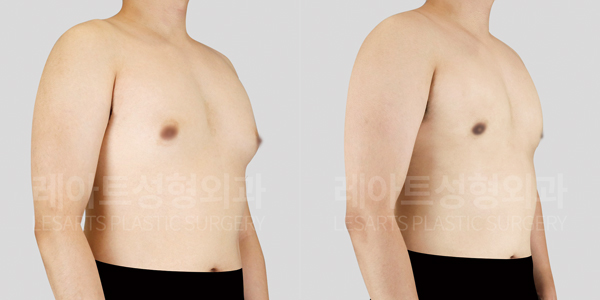Gynecomastia Surgery Before and After Comparison: Is Exercise Effective?

Information
- Age : mid 30’s
- Height : 171cm
- Weight : 66kg
- BMI : 23
Surgical site
- surgical site : gynecomastia
- grade : 2-A
Gynecomastia becomes problematic not merely due to the accumulation of fat, but because of the hormone imbalance that causes excessive growth of glandular tissue.
In this case, it’s important to receive an accurate diagnosis and plan for the appropriate treatment.
In particular, if breast protrusion persists regardless of changes in weight, it’s likely due to the overgrowth of glandular tissue. To address this, it would be advisable to visit a clinic and seek medical advice.
If ultrasound scans show that glandular tissue is the cause of the breast size, it can be improved through glandular tissue removal surgery.
Additionally, the shape of the chest can be corrected in a masculine way through liposuction and tissue rearrangement surgery.
Below, we will review before and after photos of a patient who underwent gynecomastia surgery five months ago and see the results of a more athletic-looking chest shape.

[Lesarts plastic surgery before gynecomastia surgery]
This patient is in his mid-30s and has been dealing with gynecomastia since his teenage years. He noticed the increase in chest size during adolescence, and this condition did not improve as he became an adult.
Despite losing weight, his chest size remained unchanged, and the discomfort persisted. As a result, he sought gynecomastia surgery to reduce the size and correct the shape of his chest.

[Lesarts plastic surgery before gynecomastia surgery]
The patient’s gynecomastia symptoms were clearly visible in appearance.
His chest size was large and protruding, which was confirmed as Simon Grade 2A.
An ultrasound examination also revealed glandular hypertrophy in both breasts, leading to a diagnosis of true gynecomastia.
Despite undergoing weight loss through dieting, the chest protrusion did not improve, and the patient expressed significant stress due to ongoing discomfort, particularly related to clothing and daily life.
At our clinic, we explained the treatment plan to remove the cause of the enlarged chest by performing glandular tissue removal (mastectomy) while also conducting liposuction to remove fat from the lower chest and sides, in order to create an ideal chest contour.
This approach involves removing the widespread glandular tissue with gynecomastia surgery while ensuring that the chest shape doesn’t become unnatural, and correcting the chest size and shape with liposuction. This should transform the chest into a flatter, more masculine appearance, alleviating the stress the patient had been experiencing for a long time.
Let’s now look at the before-and-after comparison photos taken 5 months after the gynecomastia surgery to review the results of the procedure.

[Lesarts plastic surgery before&after gynecomastia surgery(Taken under the same conditions 5 months after gynecomastia surgery.)]

[Lesarts plastic surgery before&after gynecomastia surgery(Taken under the same conditions 5 months after gynecomastia surgery.)]
Five months after the gynecomastia surgery, when comparing the photos, we can see that the previously protruding chest has been improved to a flatter, more athletic-looking chest shape.
In particular, the chest shape that was noticeable from the side view due to gynecomastia has been completely improved, now showing a firm, masculine chest contour.
After a stable recovery period, the patient has successfully maintained the reduced chest size created immediately after surgery, and the combination of glandular tissue removal and liposuction has resulted in a well-balanced, firm appearance without any awkwardness or skin sagging.

[5 month post-gynecomastia progress(Image for better understanding.)]

[5 month post-gynecomastia progress(Image for better understanding.)]
The patient mentioned that before the gynecomastia surgery, their biggest concern was how the chest area stood out when wearing a white T-shirt, making the outfit look unflattering.
In particular, patients with gynecomastia often find themselves stressed about their clothing, as the protruding chest size is noticeable from the side view. This leads to the need to wear larger, thicker clothes, darker colors, or layer multiple pieces to hide the chest, creating discomfort when dressing.
However, after the gynecomastia surgery, the chest size issue was resolved, and a flatter, more natural chest contour was achieved, resulting in a more balanced T-shirt fit and a significant boost in confidence.
Most notably, five months after the surgery, the smooth line of the chest was maintained without any skin sagging, and even with just a thin T-shirt, the chest looked natural and athletic, giving the patient a more masculine appearance. The patient was able to wear clothes comfortably and was highly satisfied with the results.
To maintain the results of the gynecomastia surgery, the patient was advised to be mindful of any changes in chest shape due to weight fluctuations and to maintain a regular lifestyle to prevent weight gain.